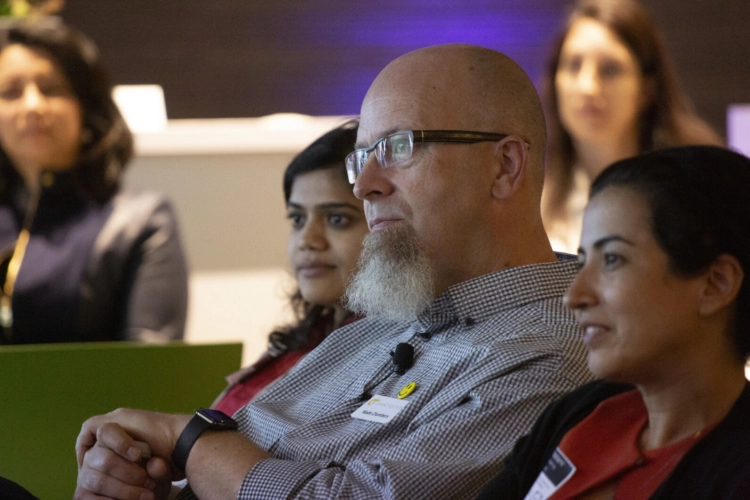Discussing LGBTQ+ Empowerment at Work with Included Health’s Founder and CEO Colin Quinn
This Q&A is re-posted from Biz Library, subscribe to their Real Talk Series and watch a recording of this webinar here (directions for how to view at bottom).
Q: Why is it so important that LGBTQ+ employees feel empowered to be their authentic selves at work?
Most people spend eight hours a day, five days a week, 12 months a year at work, and if you spend a third of your adult life masquerading as someone you are not, or hiding who you are, that is going to weigh on you! Hiding your identity can be a draining task that requires significant emotional labor, and I am speaking from experience. Earlier in my career, I was not out at work and it took a toll on my personal and professional life, including my work productivity.
Just imagine making up lies and stories to avoid having to come out! The hardest part was keeping track of each fib when employees would ask you the following week. For example, fellow coworkers would constantly ask to set me up with female friends. I’d have to use excuses like, “Oh sorry, I have family in town this weekend.” Inevitably, that coworker would ask me the following week, “How was your weekend with your family?” and I’d be confused and wondering, why are they asking about my family, but would then remember my made up tale!
To really drive this point home, I’d like to talk about a report by Boston Consulting Group which introduced the concept of 1,000 daily touchpoints. These are the hundreds of small interactions that make up your workday (conversations, phone calls, bathroom breaks, everything!). They found that negative touchpoints— comments or actions that highlight prejudice, bias, or make an individual feel isolated and unwelcomed— have detrimental effects on workplace culture.
Workplaces where LGBTQ+ employees report a high rate of negative touchpoints suffer from high turnover. The BCG study found that employees who report these negative workplace interactions are 40% less productive and 13 times more likely to quit. Those are shockingly high numbers that should concern every employer!
Q: Why is it so hard for people to come out at work?
It definitely depends on the workplace, the environment, and the team. I’ve had really easy experiences and more difficult ones. Coming out is difficult because of the unknown, meaning you don’t know how your colleagues, managers, and peers will react— whether they will accept you or ostracize you.
The unknown is a very powerful deterrent. Today, we know that 40% of LGBTQ+ people are not out at work and one-third of those who are out have lied or hidden part of their identity, such as avoided bringing their partner to work events. Sometimes we call this being “quietly out.”
Studies have shown that these aren’t unfounded anxieties; remember that concept of 1,000 daily touchpoints I mentioned? Well, in that same study, 75% of LGBTQ+ employees reported experiencing at least one negative touchpoint in the past 12 months. This could be blatant discrimination, an off-color joke, a side comment made at a meeting, whatever it is. Nearly half of employees experienced 10 or more. When you are having experiences like this in the workplace, of course people are going to be hesitant to come out!
Q: How do we combat these fears?
We must create inclusive work environments. Since we fear the unknown, we must create a strong culture of acceptance without qualifiers. You are probably thinking, “Well, Colin, of course we need inclusivity, but how do we do this?”
Harvard Business Review just published a great article on rethinking policies and workplace norms so that they benefit gender diverse employees. They suggest things like providing options for self-identification beyond traditional binaries, rethinking dress codes, and adding flexibility to existing transition policies.
Moving beyond workplace policies, I know we hear this a lot, but visibility really does matter. You can’t look at someone and tell that they are a member of the LGBTQ+ community, so we need to identify those champions in the community who are willing to be loud and proud! This will encourage others to come out of the woodwork, or at least feel more at ease in the office.
When thinking about hiring and recruiting, it is important that you have diversity (not just LGBTQ+ diversity) within your hiring and recruiting team. This will help ensure you are fishing in the right ponds. If you are recruiting undergrads this can mean reaching out to Out for Undergrad, or for business students ROMBA, Reaching Out MBA. These are some good places to start.
The other side of this coin is allyship. You need people who are not part of the community themselves, but are willing to stand up for other LGBTQ+ employees.
Q: You mentioned allyship, can you talk a bit more about the importance of allyship?
Of course! I always stress the importance of allies because, for me personally, discovering I had an ally at the company leadership level, my department’s VP, is what ultimately made me feel comfortable coming out at work.
At the minimum, allies are supportive, understanding, and accepting. Something that surprised me was, according to an Out Leadership study, 49% of people who identify as allies do not consider taking action to be part of an ally’s job. In my opinion, the best allies play an active role in championing the fight for equality, inclusion, and mutual respect. To me this means talking openly with coworkers about the importance of LGBTQ+ rights, avoiding assumptions about gender and sexuality, and speaking up when you see something that doesn’t sit right with you.
You can voice your support and allyship for the community in your daily interactions. An easy place to start is by sharing your story about why you are an ally. Everyone has a reason for getting involved with the community: maybe your brother is gay or your best friend just came out to you. Share these stories! This builds so much trust and can encourage people who aren’t out yet to share their story with you (we can have a tendency to stay hidden until we know it’s a safe space).
Another great place to start is by joining your company’s PRIDE group— these groups aren’t just for LGBTQ+ employees, and the strongest ones we see have people of all orientations and genders. Bottom line is you could be the biggest supporter of LGBTQ+ rights but people won’t know it until you say it! So get involved and speak out!
Q: Can you teach me a bit about pronouns and discuss why they are important?
Yes! I grew up in Georgia, so I was raised saying “Yes, Ma’am” and “No, Sir” to everyone around me. This language subscribes to the traditional male/female binary. Today, yes Ma’am-ing people can get you into trouble because it relies on our assumptions and inherent biases about gender! These antiquated phrases just don’t work anymore; 20% of millennials identify as LGBTQ+ and/or reject the traditional gender labels of male and female. The fact is that today, traditional male and female pronouns don’t map onto many people’s identity.
Before I go any further, we should probably take a moment to provide some examples. He/Him, She/Her, They/Them, and Ze/Hir are all pronouns that people use in our community. Using someone’s correct pronouns is so important; it’s a sign of respect and it helps pave the way towards an inclusive work environment. Asking and using pronouns is a huge signal to those of us in the community that you are open, supportive, and a potential ally.
There are many ways to incorporate pronouns into your daily life such as including them in your email signature, outside your desk or office, and incorporating them into introductions with new colleagues. Just make sure to remember to always start with yourself and your pronouns, and to ask everyone theirs, not just those that you suspect to be gender-diverse.
Q: What type of benefits should we offer to employees in the LGBTQ+ Community?
As an employer, you want to provide benefits that enable every employee to live a happy, healthy, and fulfilling life. Since the LGBTQ+ population has specific health needs that differ from the heterosexual and cisgendered population, unfortunately we are sometimes overlooked in the healthcare and benefit world. This means we should strive for benefits that are equitable, not merely equal. Not every population has the same health and wellness needs, so you might have to offer something different to different groups in order to achieve real equity.
I started Included Health a year and a half ago with this problem in mind. We conducted a national study with over 1,500 LGBTQ+ employees from Fortune 100 companies to get a feel for their healthcare experiences, existing health disparities, and to understand how they would re-imagine the healthcare experience if given the opportunity. What we found was astounding; 40% of respondents reported a negative healthcare experience or discrimination in a healthcare setting. As a result, 35% have chosen to disengage with the healthcare system completely. This number is three times greater than non-LGBTQ+ individuals.
I was floored by these numbers, and that is when Included Health really came to fruition. We wanted to rewrite our community’s care journey, so people can safely access the care they need when it matters most. What we have seen is that there are real negative impacts to not taking steps to build an equitable workplace, and a lot of great benefits that come with doing so. As they say, it is a short-term cost for a long-term gain.
Q: Could you share some suggestions for continued learning on creating inclusive work environments and any resources for LGBTQ+ employees?
For employers, D&I Leaders, and Head of Benefits:
- Human Rights Campaign Corporate Equality Index 2020
- Out & Equal
- GLAAD – the Value of LGBTQ+ Equality in the Workplace
- McKinsey Report on LGBTQ+ in the Workplace
Resources for LGBTQ Employees and Allies:
- Included Health Blog
- Gender Spectrum
- Our Families Our Future
- PFLAG
- National LGBTQ Task Force
- GLAAD’s Tips for Allies
If you want to learn more from Colin about empowering LGBTQ+ employees, be sure to view the on-demand webinar!
Accessing the Real Talk Webinar with Colin Quinn
- Follow the link above to the Real Talk Series Page
- Fill out your info in the Subscribe window and click Register
- After you register, stay on the thank you page and scroll down below the form. You’ll see links to access all the episodes in the Real Talk series. Select Episode 5.
- Enter the email address you registered with and enjoy!
About the author
Editorial Team
Our Editorial Team is composed of our leaders, clinicians, and care coordinators, as well as other Included Health employees, all who are working to raise the standard of healthcare for everyone. Together, they combine decades of subject matter experience across all fields of healthcare.



